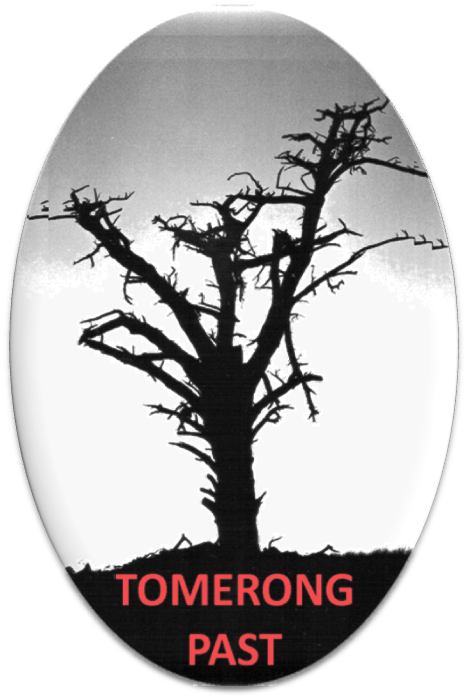THE primary source of information on this site is the Tomerong Local History book 'From Bullocks to Bypass" published in 2000. However, Tomerong Past has deposited other information on a LOCAL CONTEMPORARY MAP, FACEBOOK, TROVE, FLIKR and YOUTUBE. Details on how to access this information is provided below. The links provided will open in a new tab. You are welcome to use the information we have provided on all these sites, including this site, for non-commercial use provided you acknowledge the source and follow the copyright regulations for each platform. Some links to other sites are provided, that are not related to Tomerong Past, to provide direction if you are starting off with your research. If this site, and those linked, do not answer your questions, or you have information to contribute (e.g. photographs, historical records, memories etcetera) then Contact us. Whilst we won't conduct extensive research for you, we may have information available. Near the bottom of the page is information about Tomerong Past.
'FROM BULLOCKS TO BYPASS' traces the story of the village and its environs from the early days of settlement when farming was the main occupation. Much of the early history is also the history of the Jervis Bay and St Georges Basin area. Shortly after settlement a Hotel was constructed to cater for the highway travellers. This was followed by those essential facilities required for an isolated community; a government School, a Post Office and later, a Store. As the success of farming waned some of the settlers moved to other districts and village growth was stalled. The decline of the village was arrested by the capitalisation of the area's abundant natural resource, timber. The timber industry provided employment for the locals for over 100 years. Tomerong's importance grew as it became the headquarters for the newly-formed Clyde Shire Council and, soon after, land speculation increased as rumours of a Federal port and connecting railways flourished. The 1980's saw the end of the local timber industry and the removal of the highway in the 90's has resulted in the tranquil village life of today. This book includes the factual elements of a local history: details on the geography, the early exploration, settlement, communications, commerce, industry and local government. It traces the establishment of this community through its early settlers, how they were employed, and what community organisations they established. Wide use is made of primary sources from as early as 1855 and many quotations are provided from newspapers and interviews that add a human side to the story. The book provides a comprehensive view of how this village evolved. Whilst 'From Bullocks to Bypass' has been written with the general public in mind, it has been meticulously sourced so that other local or family historians may build on their own research. The book was five years in the making. It includes 16 maps, charts and drawings, 43 photographs, many tables, 240 pages and almost 140,000 words. It contains an index, a chronological summary (dateline) and bibliography. It is available from National, State and Regional Libraries including the Clarence, Wollongong, Shellharbour and the Shoalhaven. Although the Shoalhaven library is not listed at the NLA, the book is in the Local Studies section of Nowra Library. It may also be purchased in Tomerong for $30 (plus postage & packing if applicable). Use the Contact page to request a copy. Many local histories are only ever published once and limited copies remain. This link takes you to the National Libraries record for the book. The link on the image below gives you the introduction and contents for the book (the complete publication cannot be downloaded).
Read about: Boxing day horse race meetings where the evening celebrations lasted until daylight. The tragic case of the first fatality in the village attributed to a motor vehicle. The victorious cricket teams of the 1930s. The dispute between the users of the Church Hall and the Temperance Society. Warne's 'Gold Saving Machine'. The colourful history of the hotel that closed just as it was beginning to receive community support. The successes and disappointments of the pioneering families and settlers. The hope and speculation produced by the proposed railways and Federal port. The sacrifice paid by our World War veterans. The ever present danger of bushfires, their effect and the story of the local brigade. How the locals entertained themselves prior to the electronic era. The eager desire to establish a school and the frank Inspectors' reports from its early years. The failure of crops, the move towards dairy farming and the establishment of the Creamery Company. The early land sales and the impact of the Conditional Purchase laws. The Post Office petition where all the signatures were allegedly in the same handwriting. The visits of the NSW Governor and the Prince of Wales. The story of the first system of local government for the region that covered a vast area and had its headquarters based in the village. How the timber industry became a major factor in village life. Plus many more interesting facts and quotations.
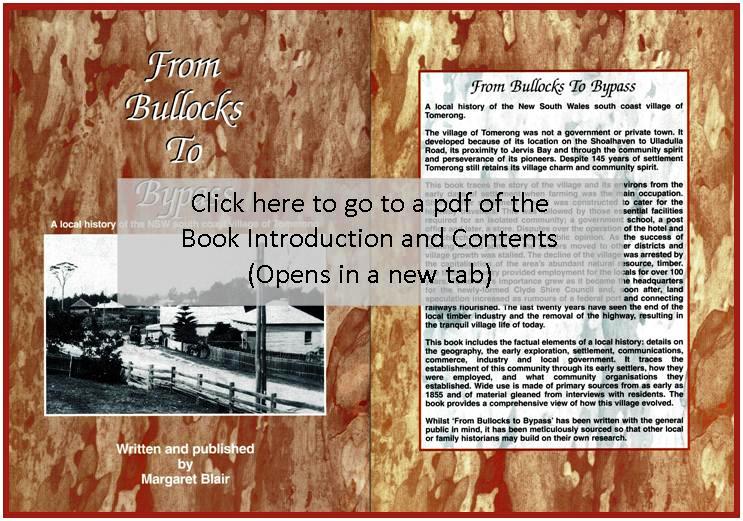
Click the image above to go to a pdf of the Introduction and Contents of 'From Bullocks to Bypass'.
SOMETIMES it is difficult to place hisorical images in their contemporary location. The Tomerong Past Historical map provides almost 100 points of historical interest about the village helping to position where buildings were located or events occurred. Zoom in, select an icon, and read about Tomerong's history. Some icons provide images of the location and may also link to 'Tomerong Past - Facebook' which may provide more information and images about the location. Some locations are approximate as they are now impossible to determine accurately. If you can assist, please Contact us. Some icons have been positioned by referencing basic maps provided to us by former timber workers in 1995 and also using Lands Department records and Parish Maps.
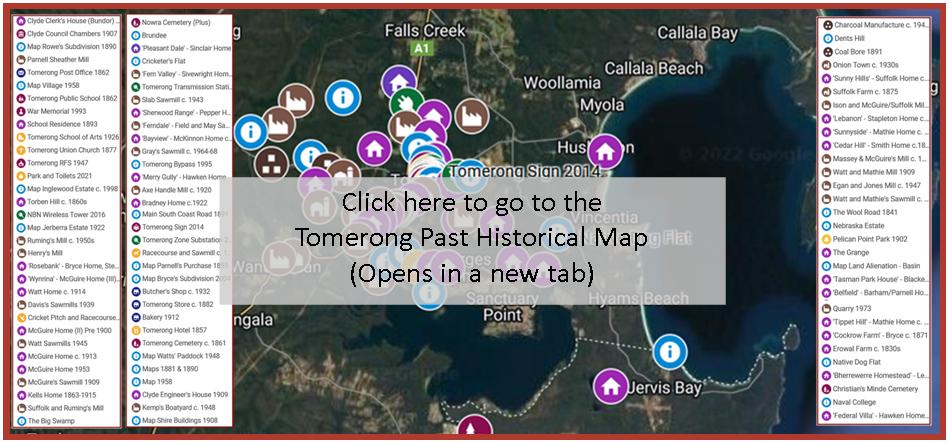
Click the image above to go to the interactive historical map of Tomerong.
FOLLOWING the School's Sesquicentenary in 2012, many of the images used in the physical Local History Displays were placed on-line on the Tomerong Past Facebook Page. When further research was conducted for the centenary of WWI in 2014, this information was also added to the page. Subsequently the site evolved to provide more information about the village's history. The site contains many photographs, images, maps and historical reserch so that it is not just a collection of old photographs. It is divided into Albums to permit easier searching if you are after specific information. Whilst further research has slowed, due to time constraints, there is a tremendous amount of information available. The 'Page' is not a 'Group' so it is available to anyone without joining, but visitor postings will need to be messaged to Tomerong Past from Facebook or placed as a reply on an existing post.
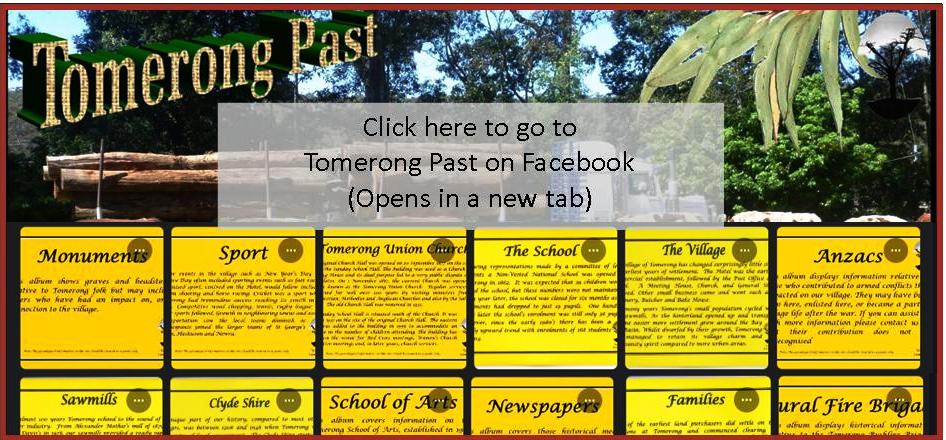
Click the image above to go to the Tomerong Past facebook site.
TROVE is the National Library of Australia's (NLA) site providing an online database of digital images and references/links to Australia's historical documents. The site can also be used to deposit documents relative to the NLA's purpose. Tomerong Past uses Trove as a repository for some documents we have written (eg. Tomerong Anzacs, John Parnell, Cyril Blacket) and images we have collected. Many of these documents and images may be downloaded. To simplify access we have placed the items in the 'Tomerong Past History List' accessible from the link below. The Work Notes on each item may assist the reader in determining whether they wish to download the item. Trove uses Flikr to access the images so most, if not all, images will also be on Flikr. More documents and images may be added over time.
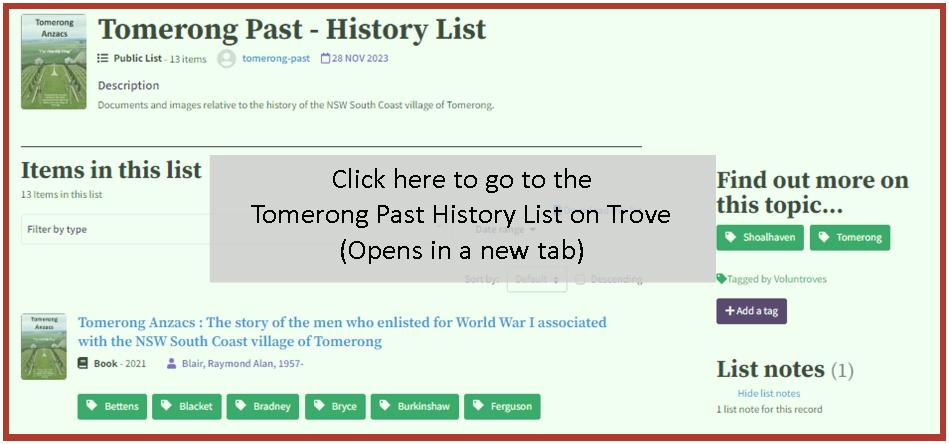
Click the image above to go to the National Libraries 'Tomerong History List' on Trove.
FLIKR is an image hosting web site and is used by the National Library to feed images into Trove. Tomerong Past uploads images to Flikr which may then appear on Trove. Not all the images on Flikr will appear on Trove. Flikr may also show where the image was taken, on a map, and provides the ability to comment on the images. More images will be added over time.
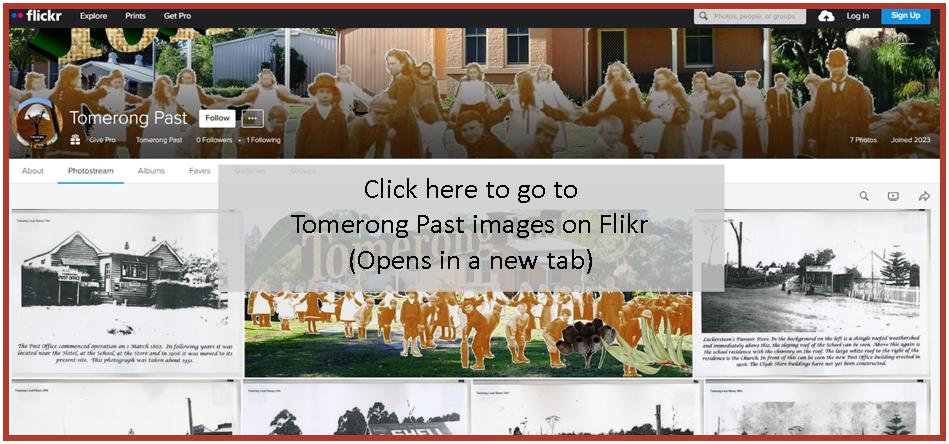
Click the image above to go to Tomerong Past Images on Flikr.
YOUTUBE is a video sharing website. Whilst some videos relative to Tomerong's History are on the Tomerong Past Facebook Page, we use YouTube for higher quality copies of those videos. A small number of videos are expected to be added. For most videos you need to ensure you have the Settings button (at the bottom of the video) set to 1080p for maximum quality.
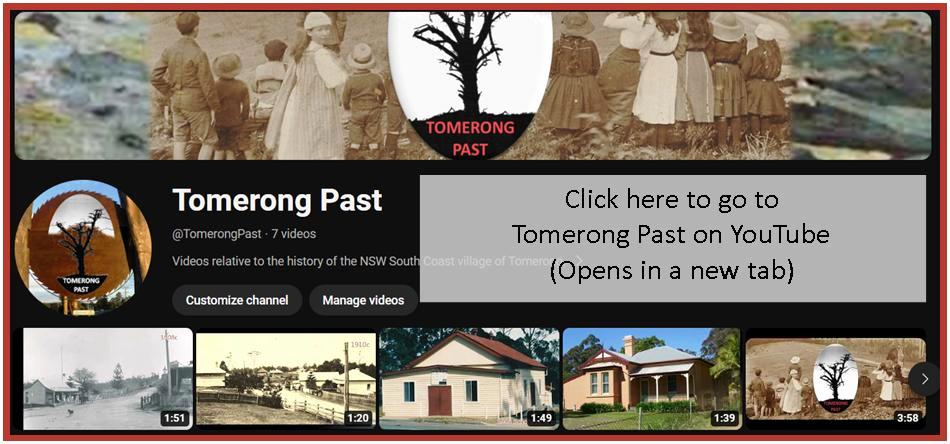
Click the image above to go to YouTube for Tomerong Past videos.
THERE are many links to get more specific details about Tomerong's History. On many you may need to have an effective search strategy to find the information of interest to you. Ensure you trust the source of the information. For instance, the data on Ancestry Public Family Trees are often copied and pasted from one family to another. So just because it occurs often doesn't mean the data is correct. We shall provide links to the most important sites below that provide free information, many more could be added. There also some links to local sites. Good luck with your research.
Tomerong Public School War Memorial
War Memorial
Shoalhaven Library Heritage Links
Shoalhaven Heritage
Free Genealogical Website
Wikitree
National Archives of Australia
NAA
NSW State Archives
State Archives
Australian War Memorial
AWM
NSW Births, Deaths & Marriages
NSW BDM
National Library of Australia
NLA
Free online Australian research portal
Trove
NSW Land Registry Services
NSW LRS
Shoalhaven Historical Society
SHS
Shoalhaven Family History Society
Shoalhaven FHS
RESEARCH commenced on Tomerong's History following the opening of the Princes Highway bypass of the village in 1995. The research culminated in the launch of the book 'From Bullocks to Bypass' at the Tomerong School of Arts in May 2001. The event included a Village Historical Walk and a Photographic Display held at the School. The Display was exhibited at other School Country Fairs and further research was conducted for the School's Sesquicentenary in 2012, after which the images were placed on facebook. Further research was also conducted for the Centenary of WWI in 2014 and other small publications were digitally published. In February 2023, Tomerong Past gave a presentation to the Shoalhaven Historical Society on the research of Tomerong's local history. The presentation covered (briefly): the research of WWI family members; Tomerong History research following the opening of the village's bypass; and how the data collected was stored, sorted and displayed. A video of the content is provided here. Whilst audio is not included, dialog boxes provide information to explain its content. You may need to set the YouTube playback quality to HD to read the smaller text and it is best viewed on a desktop or laptop. More information about Shoalhaven's History may be found at the Shoalhaven Historical Society and a bit more detail on Tomerong's History recording is displayed below under 'So what's with this TPxxxx number?'
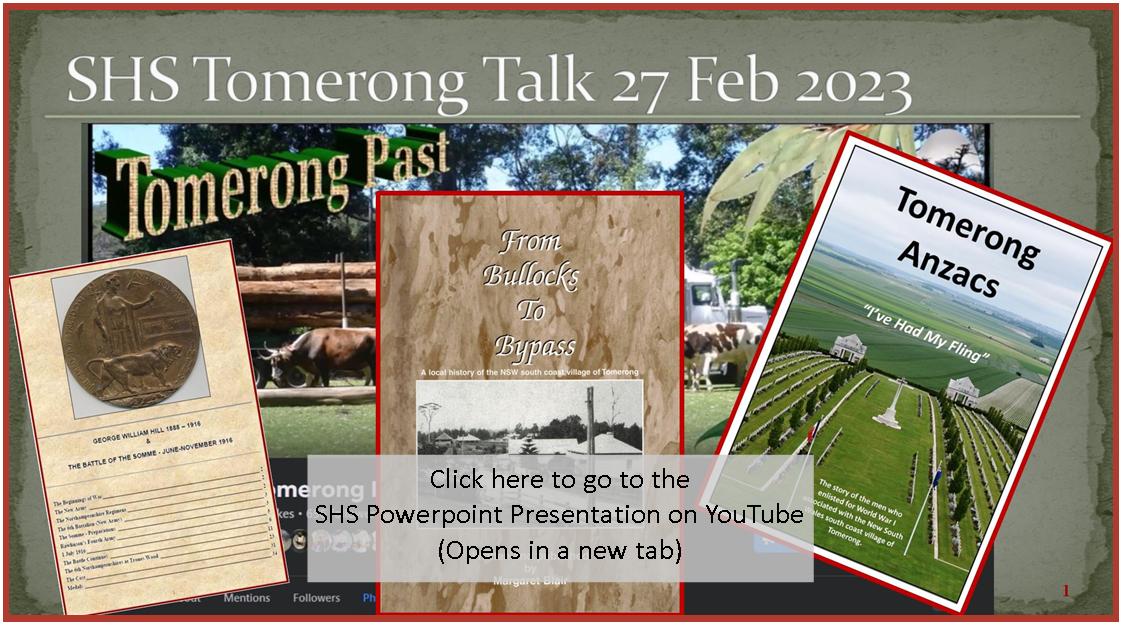
Click the image above to go to a video slide show on Tomerong History Research.
THE Tomerong Past icon shows a pine tree that was on the top of Torbin Hill (origin of name unknown, spellings various- Torbin, Torben, Tauben, Taubon). This is the hill that is on your right after the Big Dipper as you drive east from Tomerong to Huskisson. The photograph was taken at sunrise on 26 Feb 2000 but the tree was destroyed by bushfire in 2001. The tree was next to the Watt family home. Jack Kemp, the local boat builder, painted a picture of the hill for Ken and Natalie Parnell about 1965 after they had assisted Jack after an asthma attack. It's ironic that we have used a pine tree as an icon for a village with our eucalyptus sawmilling heritage but the tree was a prominent, and consequently, iconic image of Tomerong for many years. The eucalyptus does make an appearance though. It is the background of the cover of the book (Bullocks to Bypass) and also features as a background image for the mobile device menu and at the top of each of these pages. This photo of a Spotted Gum was taken on 2 Apr 2000, 800m west of the Post Office near what is now McGuire Way.
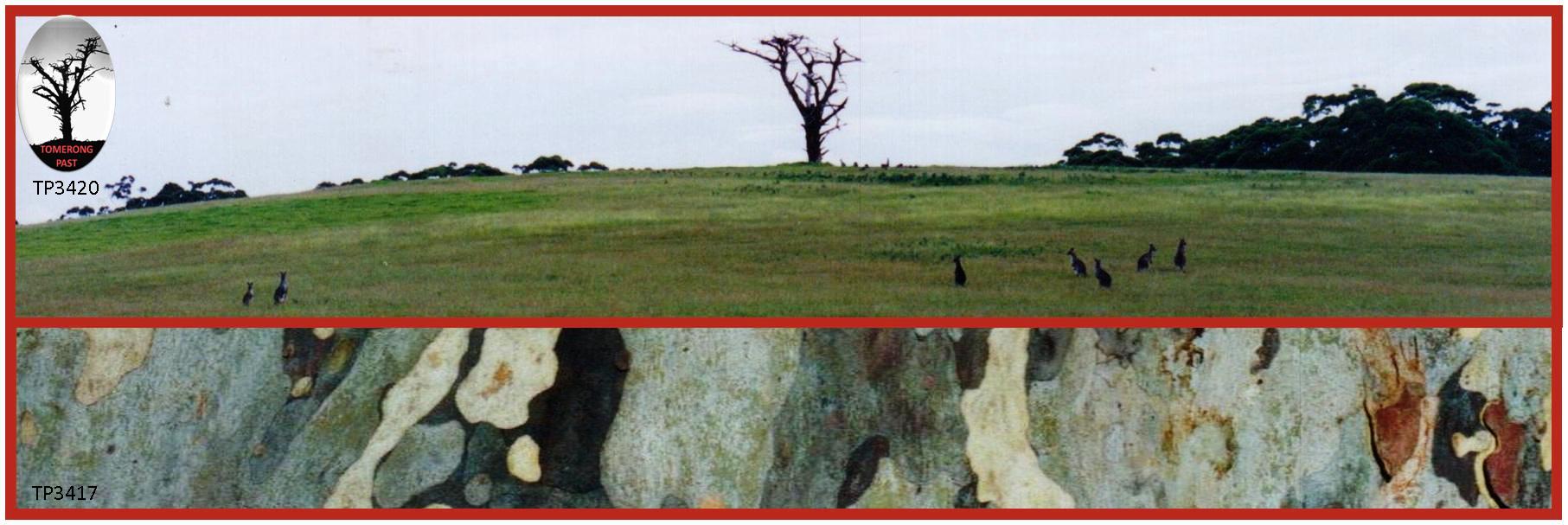
A local history is built on snippets of information from many different sources. These could be newspapers, books, government archives and records, interviews with locals, published documents, photographs, audio recordings, minutes of local organisations and other sources. Sometimes these sources contradict each other, so it is then the job of the historian to weigh up the relevance, reliability and authenticity of the various sources and make a determination. Whilst we don't always get things right, we have recorded the source/s of almost everything we have researched since 1995 and the link to the source is via the TP (Tomerong Past) database number where the information is stored. The unique number for each entry may also appear on the photograph or in the file name. The database can be filtered and queried to extract, for example, all of those entries relevant to John Parnell or the Post Office. This enables writing about a topic without shuffling reams of photocopies; although it is not unusual, on reflection, to head back to the original source. In reality, just a short paragraph of text may be attributed to many sources, as shown in the image below. The text and sources relate to the section written about the Tomerong Hotel. The first image shows an extract from the Tomerong Local History Book (Page 69) which has hidden text at the end of the paragraphs that identifies the sources used for that paragraph. One of the sources is TP546. The second image shows the notes at the end of the chapter identifying the source as the Shoalhaven News of 20 March 1909. The bottom two images shows the entry TP546 with the full text from the source. Further information about the database may be found in the presentation given to the Shoalhaven Historical Society linked above. Whilst not relevant to the reader, the TP number provides us with a quick and easy link to the original source, or perhaps more information about the reference, from almost 6000 entries in the database.
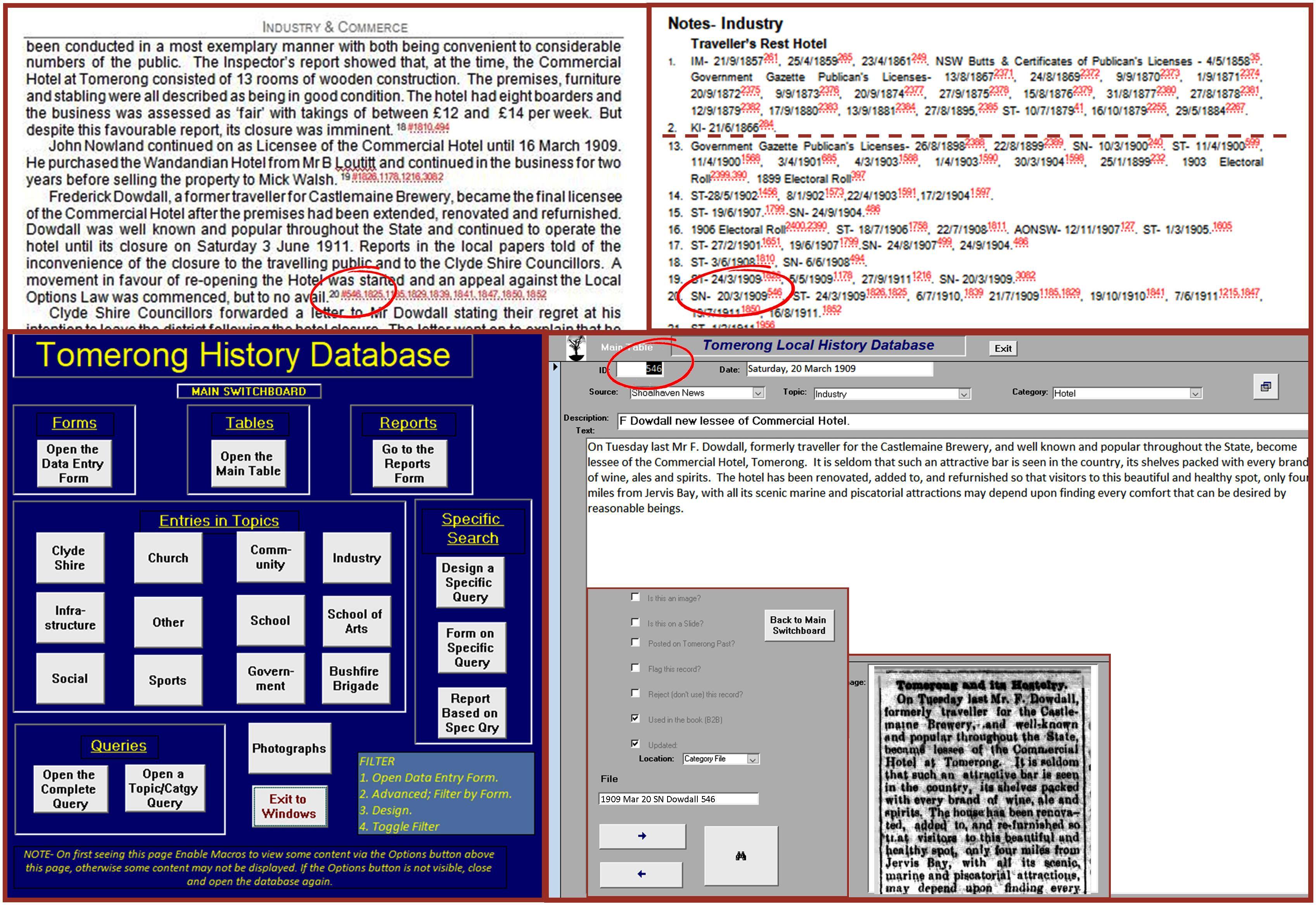
Back to Top The Next Page covers how to contact us.
